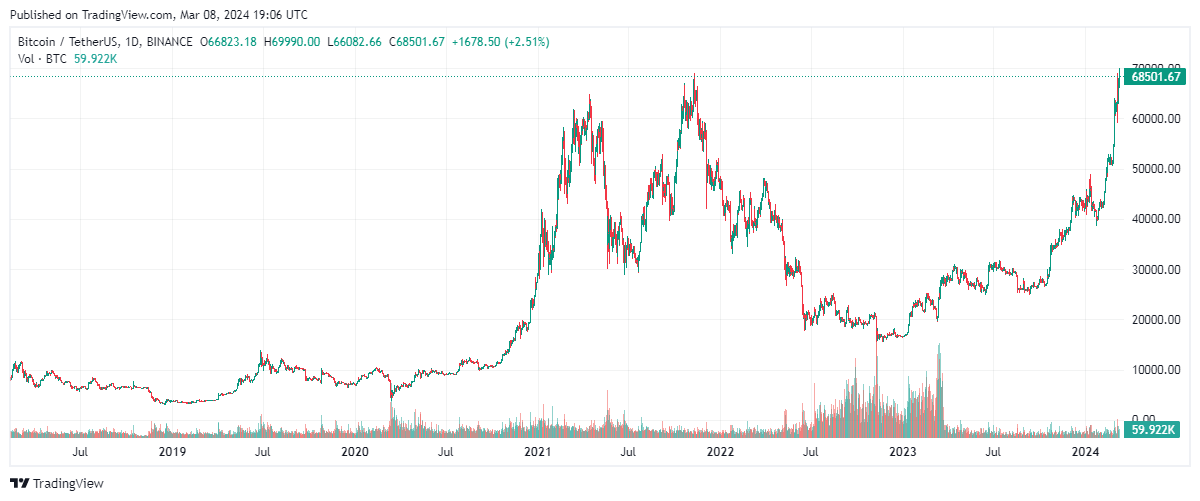
How does Bitcoin halving affect BTC price? Every four years, an event known as the “Bitcoin halving” occurs, causing a seismic shift in the cryptocurrency world. This highly anticipated event holds immense significance as it directly impacts the supply and demand dynamics of Bitcoin, potentially influencing its price trajectory.
Understanding the impact of Bitcoin halving on its price is crucial for investors, traders, and enthusiasts alike. As the flagship cryptocurrency, Bitcoin’s price movements can ripple through the entire digital asset market, making it imperative to grasp the intricate interplay between its diminishing supply and market demand.
In this article, we can unravel the economic forces at play and gain valuable insights into the potential price implications of this quadrennial event.
What is Bitcoin Halving?
Bitcoin halving is a pre-programmed event where the reward for mining new blocks is cut in half, occurring approximately every four years. Its purpose is to control Bitcoin’s supply and maintain its scarcity by ensuring the remaining coins are released at a predictable, diminishing rate until the hard cap of 21 million is reached.
While the technical details of halving are important context, the real significance lies in how this event impacts Bitcoin’s price. As the supply rate slows, basic economic principles of supply and demand come into play, with potential ripple effects across the broader cryptocurrency market.
To truly understand Bitcoin’s price dynamics, we must examine the multifaceted ways in which these scheduled halving events can influence investor sentiment, mining profitability, and overall market forces. The next section will dive deeper into the supply and demand mechanisms at work.
How Does Bitcoin Halving Affect Price?
Let us now see how the supply-demand mechanics, the role of investor sentiment, speculation, and mining profitability influence Bitcoin’s price before and after a halving event.
Supply and Demand Dynamics
At the core of Bitcoin’s price movements lies the fundamental economic principle of supply and demand. Just like any other asset or commodity, when supply is limited and demand remains constant or increases, prices tend to rise. Conversely, an oversupply coupled with stagnant or declining demand can lead to price decreases.
Bitcoin halving directly impacts the supply side of this equation. With each halving event, the rate at which new Bitcoins enter circulation is slashed in half, effectively constricting the supply. This artificial supply constraint is often met with sustained or increasing demand from investors seeking to own a share of the limited Bitcoin supply.
The potential price impact of this supply squeeze can be observed through historical data. For instance, in the year following the second halving in 2016, Bitcoin’s price skyrocketed from around $650 to nearly $20,000 by December 2017 – an astronomical gain of nearly 3,000%. While multiple factors contributed to this rally, the halving-induced supply shock undoubtedly played a significant role in driving up prices.
Similarly, after the most recent halving in May 2020, Bitcoin’s price climbed from around $8,000 to an all-time high of over $68,000 by November 2021, despite the COVID-19 pandemic’s economic turmoil. This price surge can be partially attributed to the heightened scarcity resulting from the reduced mining rewards.
The same thing is currently happening with the price of Bitcoin surging above $69,000 on March 5th.

However, it’s essential to note that supply is just one side of the equation. Demand dynamics, fueled by factors like institutional adoption, regulatory changes, and overall market sentiment, also play a crucial role in shaping Bitcoin’s price trajectory after a halving event.
Investor Sentiment and Speculation
Bitcoin halving events have historically acted as catalysts for heightened speculation and shifting investor sentiment. As the countdown to a halving begins, anticipation builds within the community, fueled by the narrative of impending scarcity and potential price appreciation. This anticipation can lead to a speculative frenzy, with investors rushing to accumulate Bitcoin in hopes of profiting from the expected post-halving price surge.
The 2017 bull run serves as a prime example of this phenomenon. In the lead-up to the second halving in 2016, Bitcoin’s price remained relatively stable, hovering around $500-$600. However, as the halving approached, speculation intensified, and the price began a meteoric ascent, eventually peaking at nearly $20,000 in December 2017 – just over a year after the event.
This speculative behavior is often driven by the fear of missing out (FOMO) and the allure of potential gains. Investors may perceive halving as a once-in-four-year opportunity, prompting them to enter the market or increase their holdings, thus driving up demand and, consequently, prices.
However, it’s crucial to remember that speculation is a double-edged sword. While it can fuel price rallies, it can also lead to market corrections and volatility if the hype fails to meet reality or if investors seek to cash in on their gains.
Mining Profitability and Difficulty Adjustment
Bitcoin halving events have a direct and substantial impact on the profitability of mining operations. Miners are rewarded with newly minted Bitcoins for successfully validating transactions and adding new blocks to the blockchain. When the block reward is halved, miners effectively see their revenue slashed by 50% overnight.
This reduction in mining profitability can have ripple effects on the broader Bitcoin ecosystem. In the aftermath of a halving, some miners may be forced to shut down their operations due to diminished returns, leading to a temporary decrease in the network’s overall hash rate (computational power). However, this decline is typically short-lived, as the Bitcoin network automatically adjusts its mining difficulty to maintain a consistent block production rate of approximately one block every 10 minutes.
Interestingly, the relationship between mining profitability and Bitcoin’s price is a complex one. While lower profitability may prompt some miners to exit the market, potentially reducing sell pressure from their Bitcoin sales, it could also incentivize remaining miners to hold onto their rewards in anticipation of higher prices. This dynamic can influence supply and demand forces, potentially contributing to upward price movements.
Read also! Is Bitcoin Halving Good or Bad?
Historical Price Trends Around Halving Events
Examining Bitcoin’s price behavior around past halving events can provide valuable insights into potential patterns and trends. While past performance is no guarantee of future results, analyzing historical data can shed light on the market’s response to these supply-altering events.
Before the first halving in 2012, Bitcoin’s price hovered around $10-$12. In the months following the event, the price gradually climbed, eventually reaching an all-time high of over $1,000 by late 2013 – a staggering 10,000% increase from pre-halving levels. This unprecedented rally was fueled by a combination of factors, including increased media attention, growing adoption, and speculation surrounding the novel digital currency.
The lead-up to the second halving in 2016 saw Bitcoin’s price consolidate around $500-$600, with relatively low volatility. However, in the year following the event, the price skyrocketed from around $650 to nearly $20,000 by December 2017, marking the start of the infamous “crypto bull run” that captured the attention of mainstream investors and the public alike.
The most recent halving in May 2020 occurred during a period of economic turmoil caused by the COVID-19 pandemic. Despite the global uncertainty, Bitcoin’s price demonstrated resilience, climbing from around $8,000 prior to the halving to an all-time high of over $68,000 by November 2021.
While these historical price movements cannot be solely attributed to halving events, they highlight the potential impact of these supply-altering occurrences on investor sentiment, speculative behavior, and overall market dynamics.
Expert Opinions and Predictions
As the next Bitcoin halving event approaches, scheduled for April 2024, industry experts and analysts have weighed in with their predictions and forecasts for its potential impact on the cryptocurrency’s price.
Renowned crypto analyst Willy Woo believes that the upcoming halving could catalyze a “supply crisis” that drives Bitcoin’s price to new heights. In an interview with Forbes, he stated,
“The upcoming halving in 2024 will see a supply crunch that will make the previous two halvings look like a warm-up act.”
However, not all experts share such bullish sentiments. Nic Carter, a partner at Castle Island Ventures, strikes a more cautious tone, arguing that the impact of halving events is already priced in by the market.
“I think the halving is overhyped as a price driver,” Carter told CoinDesk. “The market has known about it for over a decade, and it’s widely anticipated.”
Offering a balanced perspective, Cathie Wood, CEO of Ark Investment Management, acknowledges the potential for short-term volatility but remains optimistic about Bitcoin’s long-term trajectory.
“We could see some turbulence around the halving event itself, but our conviction remains high that Bitcoin’s fundamentals are incredibly strong,” she stated in a recent interview with CNBC.
These diverse viewpoints underscore the complexity and uncertainty surrounding Bitcoin’s price dynamics, highlighting the importance of considering multiple factors beyond just the halving event itself.
Conclusion
Bitcoin halving is a pivotal event that has historically sent shockwaves through the cryptocurrency market, influencing supply dynamics, investor sentiment, and overall price movements.
Throughout this article, we have explored the intricate ways in which halving events can impact Bitcoin’s price. From the basic economic principles of supply and demand to the role of speculation and investor psychology, each factor contributes to the complex interplay that ultimately shapes Bitcoin’s price trajectory.
While historical data suggests a potential for significant price appreciation following halving events, it is crucial to remember that past performance does not guarantee future results. The cryptocurrency market remains highly volatile and unpredictable, subject to a myriad of external factors beyond just the halvings themselves.
As we approach the next halving in 2024, it is essential for investors, traders, and enthusiasts alike to stay informed, conduct thorough research, and make informed decisions based on their individual risk tolerance and investment goals.
